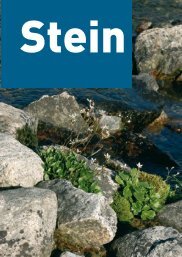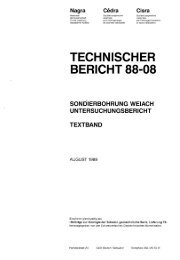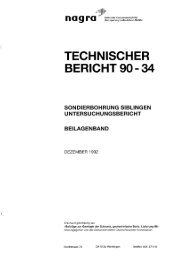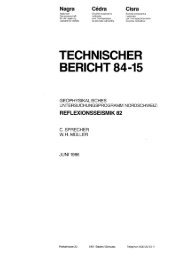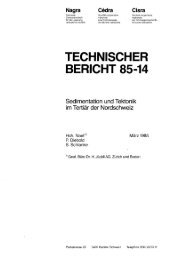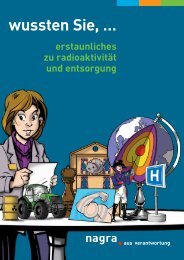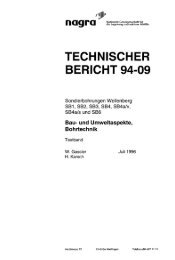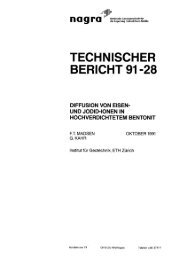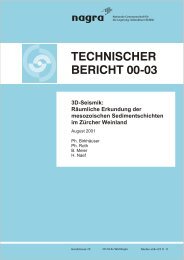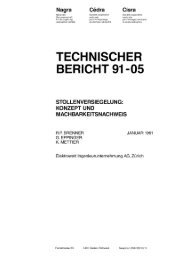TECHNICAL REPORT 92-14 - Nagra
TECHNICAL REPORT 92-14 - Nagra
TECHNICAL REPORT 92-14 - Nagra
Create successful ePaper yourself
Turn your PDF publications into a flip-book with our unique Google optimized e-Paper software.
NAORA NTB <strong>92</strong>-<strong>14</strong> - 22-<br />
The (true) stress-strain relations from the experiments for the two strain rates<br />
are shown in Figure 2.2; the curves at 900 °C match those at 800 °C and<br />
therefore are not included in the figures. The temperature dependency of<br />
the modulus of elasticity E and the yield limit RpO.2 is given in Figure 2.3.<br />
The two further parameters which are necessary for a time independent,<br />
thermomechanical calculation, i.e. the Poisson ratio v and the coefficient of<br />
thermal expansion CY, are represented in Figure 2.4. The values of these parameters<br />
are taken from (RICHTER 1973) for a weldable fine-grained steel.<br />
The coefficient of thermal expansion CY is reduced at 800 °C, thus indicating<br />
some transformation plasticity at the ferrite-austenite transformation.<br />
2.2.3 Creep tests<br />
In this work, creep is understood as a flow which is time dependent and<br />
which is possible for any stress; yielding is understood as a flow which<br />
arises only when the stress is above a certain threshold level, namely the<br />
yield limit.<br />
The influence of creep on the material behaviour increases with increasing<br />
temperature; at temperatures such that the creep response time, even under<br />
low stresses, is smaller than the time constant of the temperature history,<br />
only small stresses can build up. It is therefore necessary to estimate the<br />
limiting temperature below which creep can be neglected for time horizons<br />
of the order of the duration of the cooling period after completion of the<br />
weld: significant residual stresses can build up only below that temperature.<br />
In order to address this issue, to determine the creep behaviour of OS-40 cast<br />
steel and to develop an adequate mathematical description of the primary<br />
and secondary creep, a series of creep tests under constant loading were<br />
carried out on samples (diameter 8 mm, gauge length 38 mm) of OS-40<br />
cast steel at the three temperatures 400 °C, 550°C and 700 °C (ROSSELET<br />
1990). Figure 2.5 shows the creep curves obtained in the tests. It can be<br />
seen that already ,at 400 °C the primary creep rate is important. Also at<br />
this temperature an important strain hardening is observed, i.e. the creep<br />
rate decreases rapidly with time (Figure 2.5a). By contrast, at 700 °C (Figure<br />
2.5c), the strain hardening is practically compensated by the recovery<br />
and primary creep is not observed.<br />
2.2.4 Implementation of the material properties into a finite element<br />
calculation<br />
The time independent stress-strain relations are represented in the finite<br />
element calculations either by a multilinear, temperature- and strain ratedependent<br />
or by a bilinear, temperature-dependent material law . The former<br />
is implemented into the material model by a table, the latter is given by the<br />
input. The bilinear material law is based on the experimental values with a



